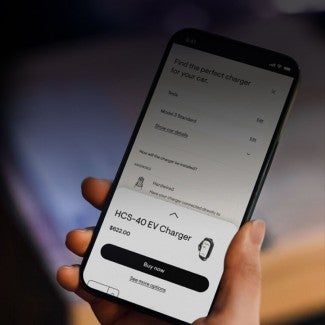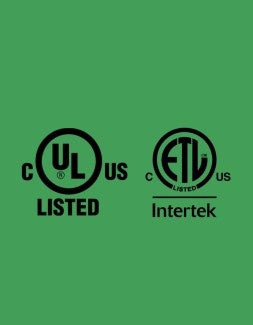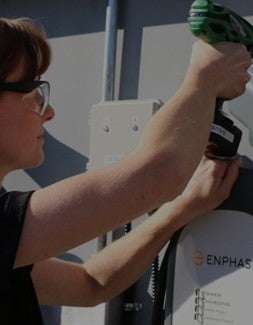Your guide to EV charging
From selecting the perfect EV charger to making the most of every charge, our FAQs, videos, and articles will help you every step of the way.
A standard home charging station, whether it is a Level 1 (120 V) station or a Level 2 (240 V) station, will provide pass through AC power to the vehicle for charging. The vehicle will convert this AC power to DC power and utilize the DC power to recharge its batteries. The actual battery charger is on-board the vehicle. EV charging stations essentially act as electrical safety equipment that, first and foremost, ensure safety for the user, then the vehicle, and then the power grid. A charging station implements several layers of redundant safety features to protect the user from potential electrical hazards while connecting and disconnecting the station to the vehicle for charging. Once connected to the vehicle the EV charging station will inform the vehicle that power is available and at what level. From that point the vehicle takes over to initiate and take full control of the power transfer, unless an electrical fault occurs, in which case the station will stop the power transfer immediately.
Enphase has created an EV charger selector tool to make it easy for you to find the right EV charger for your EV. The tool will recommend a charger based on your EV make and model. Additionally, you can learn about calculating battery charging times and power acceptance rates.
There are two “levels” of chargers (Level 1 and Level 2) used for home EV charging. They deliver different charging speeds for charging your EV at home. Level 1 chargers are very slow, while Level 2 chargers offer faster charging.
Typically, EVs come with a Level 1 or “trickle” charging station in the trunk of the car for portability. The Level 1 charging station plugs into any standard 120 V household outlet to charge your EV. This delivers a very slow charge and typically provides about 4-5 miles of range per hour of charge. For some drivers this is enough.
Many EV drivers want the option to charge their EV at a faster rate. Level 2, or 240 V, charging stations offer higher speed charging. Level 2 chargers require a dedicated 240 V line to the charging station, and there are various power levels (and, hence, charging speeds) available from Level 2 charging stations. A Level 2 charging station can provide between 16 to 60 miles of range per hour of charge, depending on the vehicle that is being charged and the charging station being used.
To learn more about calculating charging times and EV charge acceptance rates, read our EV charging time article.
Some Enphase EV Chargers are designed for hardwired installation and others for plug-in installation. The hardwired EV chargers include service wires which are routed through a three-foot flexible conduit with an additional six inches of wire extensions for easy installation into a junction box. With a hardwired EV charger the installation is more permanent, the EV charger can still be moved, but you would need an electrician to uninstall the EV charger and then reinstall it at your new location. Hardwire Enphase EV Chargers are rated for indoor or outdoor installation.
With a plug-in EV charger, it will come with a high-quality, over-molded 240 V plug attached instead of the flexible conduit included with a hardwired charger. The plug length is 12 inches, the longest length allowed per National Electric Code, and this includes the plug itself in the measurement.
Additionally, we offer two different types of 240 V plugs—NEMA 14-50 and NEMA 6-50—with our charging stations. For a plug-in installation, the electrician should verify the wiring and upstream circuit breaker are adequate to deliver the EV charger power rating. The electrician should also ensure the receptacle supplied with the product is installed with the EV charger. This delivers the safest installation for a plug-in charger.
Always use a qualified electrician when installing EV chargers and supporting equipment. To find a local qualified installer, visit our EV charger installer locator.
Three key elements determine how fast an EV battery will charge:
-
Battery size and storage, which differs by EV
-
Power acceptance rate, which differs by EV
-
EV charging station maximum power delivery rating, which varies by EV Charger
To determine how fast an EV charger will charge a given EV, here are the basic rules to consider:
-
If the charging station offers less power than the vehicle's maximum acceptance rate, the charging station would be the limiting factor in determining the charge time.
-
If the vehicle's acceptance rate is lower than the charging station's maximum output rate, then the vehicle will be the limiting factor.
-
To determine your estimated total charge time, you would take your vehicle battery pack rating and divide it by whichever number is lower, the vehicle's acceptance rate, or the station's output rate.
Most vehicles will provide this information through the dashboard interface once you plug into a charging station. You can also get more details about calculating battery charging times and power acceptance rates in our EV charging time article.
Our EV charger selector tool makes it easy to find the right EV charger for your EV make and model.
There are many programs around the country that provide incentives for installing a Level 2 EV charger. Here are the federal, state, utility, and private incentives that we know about: EV charger rebates and incentives by state.
We recommend you contact your local utility or check the US Department of Energy Laws and Incentives website for any other incentives that may be available for installing a Level 2 EV charger.
We recommended that you have a qualified electrician install your EV charger because there are certain electrical requirements for the product itself, wiring size requirements, and local electrical codes that an electrician will have knowledge of, which ensures that the charging station will be installed properly and safely.
A qualified electrician can also assess the home’s current electrical infrastructure and advise you if there's any additional work necessary (for example, an electrical panel upgrade in an older home). Most homes will have capacity available, and the work will merely be wiring the station to a dedicated circuit in the case of a hardwired charger or installing an appropriate and safe receptacle/outlet in the case of a plug-in charger. To find a local qualified installer, visit our EV charger installer locator.
Yes. For outdoor installations we recommend installing a hardwired 240 V EV charger. All Enphase EV Chargers have a fully sealed NEMA 4 enclosure that provides superior protection to the components inside the charger from outdoor elements.
We recommend a hardwired EV charger for an outdoor installation as it provides better weather protection for the connection to power. If you install a plug-in EV charger outdoors, we recommend installing a watertight cover over the plug and outlet combination.
We also recommend checking with a licensed electrician to ensure installing a 240 V plug-in EV charger outdoors meets your local codes. There was a change in the National Electric Code requirements at the beginning of 2017 that allowed plug-in 240 V EV chargers to be installed outdoors, however sometimes local codes can vary.
To find a local qualified installer, visit our EV charger installer locator.
Yes, the charging head on Enphase EV Chargers are designed to drain water and the inlet on your vehicle is designed to drain water as well. Once the charging head is connected into your vehicle’s inlet, a water-tight seal will be formed.
These two listings are predominantly about user safety and product quality. UL and ETL are both considered Nationally Recognized Testing Laboratories (NRTL). NRTLs provide independent safety and quality certifications for electrical appliances. UL develops the testing standards and tests to them, ETL tests to UL standards.
Products with UL or ETL listings are recognized as safer than units without these listings. Make sure the logos of one of these testing laboratories are shown directly on the product you purchase to ensure its safety.
An inspector sign-off on a permitted installation in line with the National Electric Code requires that the EV charger be NRTL listed (in the US that is either with ETL or UL). Enphase uses both laboratories.
No, using a higher amperage EV charger will pose no harm to the vehicle. EV chargers are a pass-through, electrical safety appliance. The EV is in complete control of the charge and will only take the power it can accept and no more. The actual charging takes place on the vehicle. Our units will supply AC power to the vehicle and the vehicles onboard charger will convert the AC power to DC power and charge the vehicle’s batteries.
For example, a Chevy Volt can take in 3.3 kW for charging and the HCS-40 EV charger can deliver up to 7.7 kW. When an HCS-40 EV charger is plugged into the Volt the station will “tell” the Volt how much power is available through the charger's communication system. From that point the vehicle will take over, activate the charger and accept the power it wants, up to the limit established by the EV Charger.
Some of our customers purchase EV chargers that offer a higher power level than their current vehicle can accept, which allows them to future proof their installation in anticipation of purchasing a vehicle that could accept more power.
Enphase products consume very minimal power when not in use. We call this “standby power,” and the draw on the HCS EV charger for standby power is approximately two watts. For comparison, leaving an HCS-40 EV charger powered up for about 50 days would use the same amount of power as leaving on a 100 watt light bulb for 24 hours (a very small amount).
Enphase EV Chargers do not come with a power switch because the standby power consumption is so low, and a switch could be forgotten, or accidentally not turned on, resulting in your EV not receiving its charge.
Enphase EV Chargers work with virtually every EV sold in North America. The industry standard connector in North America is SAE J1772. Commonly referred to as a “J-plug.” All Enphase EV Chargers come with this type of connector and can be used with any electric vehicle. While Tesla uses its own proprietary connection interface, they provide a connection adaptor which can also be used with Enphase EV Chargers.
Yes, our EV chargers provide pass-through electricity and will not supply power to the EV unless the vehicle is requesting a charge. The vehicle is in complete control of the charge and if a timer is set within the vehicle the EV charger, even if plugged into the car, will not supply power to the vehicle until the vehicle requests a charge at the scheduled time.
Note: Our HCS products do not currently work with the charging timers of the Nissan Leaf 2023 and Mercedes-Benz EQS 2022-2023.
You can visit websites such as PlugShare or Google Maps which allow you to search by address, city, or zip code to find stations in your area. Google Maps and PlugShare both show charging stations along with other helpful information from their respective community of users. The services are also available as apps that you can download to your smartphone for a convenient way to search for stations when you are on the go.




































